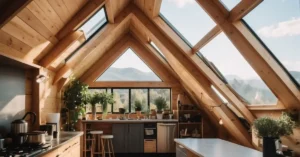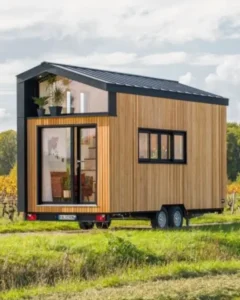Fundamentals of Tiny House Ceiling Design
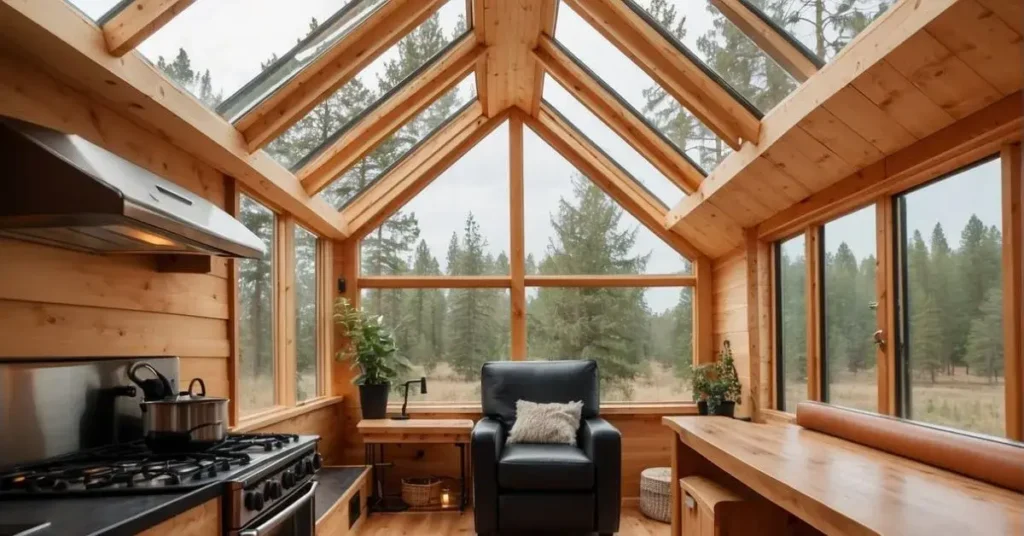
In tiny houses, ceiling design plays a critical role in the feeling of spaciousness and comfort. This section delves into the scale, proportion, and materials that are foundational to crafting ceilings that enhance tiny home living.
Understanding Scale and Proportion
Tiny house ceilings require thoughtful consideration of scale and proportion. Designers often recommend higher than normal ceilings which help to visually expand the space, drawing the eye upwards. This technique makes the tiny house interior appear larger. It’s also useful to consider slim, linear lighting fixtures that don’t overwhelm the space but rather complement the ceiling’s height.
Material Selection for Tiny House Ceilings
The choice of materials for tiny house ceilings impacts not just aesthetics but also the sense of space. Lightweight materials, such as wooden panels or metal sheets, are popular choices due to their practicality and stylistic versatility. For a rustic look, exposed wooden beams are an excellent option, as they add character while visually raising the ceiling height. Alternatively, the use of reflective materials like metal can help to bounce light around the room, making the space feel airier and more open.
Creative Tiny House Ceiling Ideas
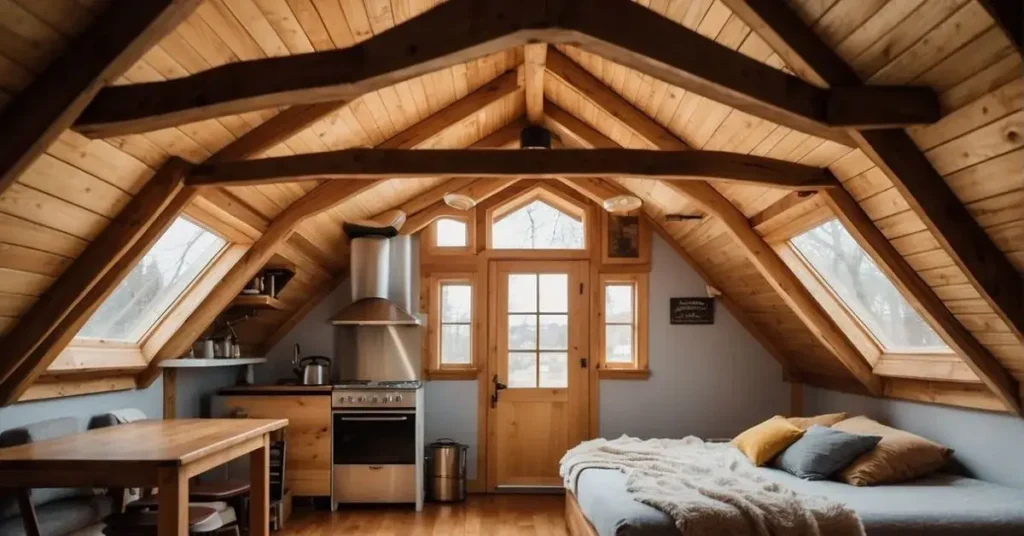
While small in square footage, tiny houses can feature big style and function with clever ceiling designs. This section explores some innovative ideas to make ceilings in tiny homes stand out and enhance the living space.
Incorporating Skylights and Natural Light
Skylights are a fantastic way to introduce more natural light into a tiny house, making the space feel larger and more open. Homeowners might consider installing skylights to not only brighten their home but also to provide a view of the sky, which can add a sense of freedom and expansion beyond the home’s physical boundaries.
Using Color and Texture to Enhance Spaces
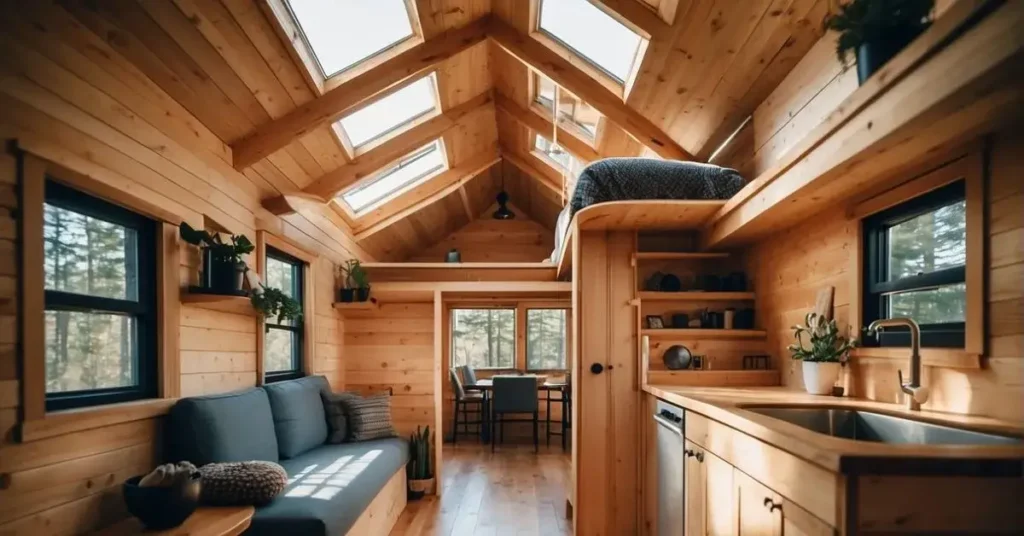
Applying various colors and textures to a ceiling can dramatically change the perception of space in a tiny house. Lighter colors tend to make spaces seem more expansive, while interesting textures can add depth and character. Some tiny house enthusiasts get creative with patterned wooden panels or vintage tiles to create a unique fifth wall.
Innovative Storage Solutions
Ceilings in tiny houses can double as storage areas, a smart strategy for utilizing every inch of available space. Overhead storage compartments or hanging shelves provide places to keep belongings that are infrequently used. For example, the area above a kitchen can hold pots and pans, or above the living area can store books or seasonal items. This approach makes sure that the living spaces remain uncluttered and functional.
Technical Considerations for Tiny House Ceilings
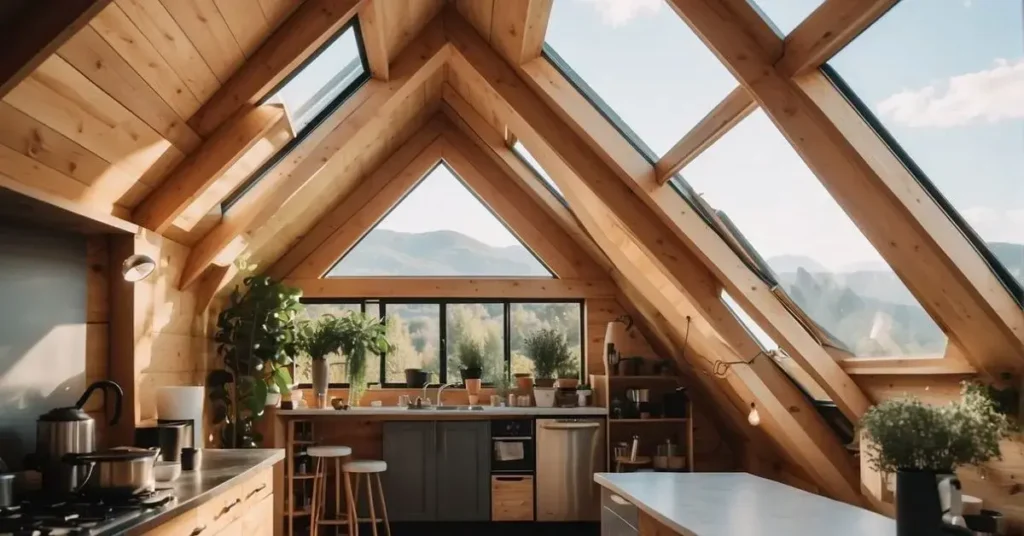
When designing ceilings for a tiny house, two critical technical aspects demand attention—insulation for energy efficiency and ventilation for proper air circulation. These elements are key to maintaining a comfortable and sustainable living environment in a compact space.
Insulation and Energy Efficiency
Insulation is paramount in a tiny house ceiling to maintain temperature control and reduce energy costs. Optimal insulation materials include spray foam, rigid foam panels, and fiberglass batts. Spray foam insulation provides an excellent thermal barrier and is known for its ability to seal gaps, preventing air leakage.
- Spray Foam: Great for sealing gaps, high R-value (thermal resistance).
- Rigid Foam Panels: Easy to install, offers continuous insulation without thermal bridging.
- Fiberglass Batts: A cost-effective option, though requires careful installation to prevent gaps.
The choice of insulation material affects the R-value, which measures the capacity to resist heat flow. A higher R-value implies better insulating power, which is vital in both hot and cold climates.
Ventilation and Air Circulation
Ventilation is also crucial in a tiny house ceiling design. Proper air flow mitigates moisture accumulation, which can lead to mold growth and air quality issues. A well-designed ceiling should integrate a ventilation system, such as passive vents or active exhaust fans, that works in tandem with windows and doors to promote cross-ventilation.
- Passive Vents: Allow air to move naturally without mechanical support.
- Active Exhaust Fans: Mechanical fans that promote air exchange, reducing humidity and stale air.
It’s essential to also consider the placement of these ventilation features to optimize air movement. Strategic placement could include areas such as the highest point in the ceiling or near the shower to deal promptly with humidity. If you want to turn your ceiling into a loft right away, be sure to take a look at our article Tiny Home with Loft: 15+ Inspirations for your Home.
If you prefer to get inspiration from a video, I recommend this one:
Frequently Asked Questions
Is shiplap a good material for tiny house ceilings, and if so, how can it be effectively incorporated?
Shiplap is an excellent choice for tiny house ceilings as it adds character and can make a space seem larger when laid in a vertical pattern. One can even paint it in light hues to enhance the effect.
What are some uncomplicated ceiling designs suitable for a tiny home?
Smooth, painted finishes are a straightforward option, giving a clean and open feel. Paneling or wooden slats are also uncomplicated designs that add texture and depth without overpowering a tiny home’s interior.
What ceiling options are recommended for tiny spaces to avoid feeling cramped?
Choosing light colors for the ceiling can make the space feel more open and airy. Installing taller than normal ceilings or using reflective materials like metal can also create the illusion of more space.
Could you suggest any modern ceiling designs specifically for small houses?
For a modern touch, one might consider a minimalist approach with smooth surfaces and recessed lighting. Innovative materials like architectural tiles or layer-on layer ceilings can also bring a contemporary look.
Are there creative ways to decorate tiny house ceilings that enhance the overall aesthetic?
Certainly, from adding wallpaper to the ceiling for a bold statement to installing decorative lighting fixtures, the options are plentiful. Exposed beams can also add dimension and character.
If you liked this blog article about the topic “Tiny House Ceiling Ideas”, don’t forget to leave us a comment down below to tell us about your experience.
Not enough inspiration yet?
Feel free to also check out our other Articles from the category “Tiny House“ and don’t forget to follow us on Pinterest.

